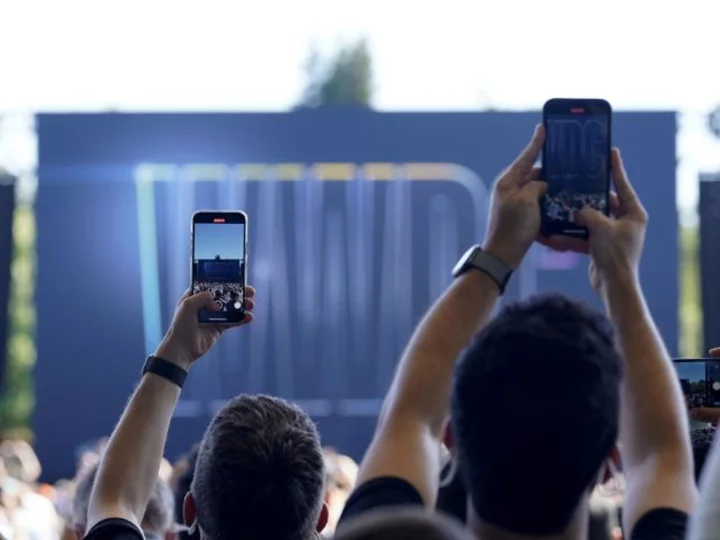Apple may be just one day away from unveiling its most ambitious new hardware product in years.
At its Worldwide Developers Conference, which kicks off Monday at its Cupertino, California, campus, Apple is widely expected to introduce a "mixed reality" headset that offers both virtual reality and augmented reality, a technology that overlays virtual images on live video of the real world.
The highly anticipated release of an AR/VR headset would be Apple's biggest hardware product launch since the debut of the Apple Watch in 2015. It could signal a new era for the company and potentially revolutionize how millions interact with computers and the world around them.
But the headset is just one of many announcements expected at the developers event. Apple will also show off a long list of software updates that will shape how people use its most popular devices, including the iPhone and Apple Watch.
Apple may also tease how it plans to incorporate AI into more of its products and services, and keep pace with a renewed arms race over the technology in Silicon Valley.
The event will be livestreamed on Apple's website and YouTube. It is set to start at 10:00 a.m. PT/1:00 p.m. ET.
Here's a closer look at what to expect:
A 'mixed reality' headset
For years, Apple CEO Tim Cook has expressed interest in augmented reality. Now Apple finally appears ready to show off what it's been working on.
According to Bloomberg, the new headset, which could be called Reality One or Reality Pro, will have an iOS-like interface, display immersive video and include cameras and sensors to allow users to control it via their hands, eye movements and with Siri. The device is also rumored to have an outward-facing display that will show eye movements and facial expressions, allowing onlookers to interact with the person wearing the headset without feeling as though they're talking to a robot.
Apple's new headset is expected to pack apps for gaming, fitness and meditation, and offer access to iOS apps such as Messages, FaceTime and Safari, according to Bloomberg. With the FaceTime option, for example, the headset will "render a user's face and full body in virtual reality," to create the feeling that both are "in the same room."
The decision to unveil it at WWDC suggests Apple wants to encourage developers to build apps and experiences for the product in order to make it more compelling for customers and worth the hefty price tag.
The company is reportedly considering a $3,000 price tag for the device, far more than most of its products and testing potential buyers at a time of lingering uncertainty in the global economy. Other tech companies have struggled to find mainstream traction for headsets. And in the years that Apple has been rumored to be working on the product, the tech community has shifted its focus from VR to another buzzy technology: artificial intelligence.
But if any company can prove skeptics wrong, it's Apple. The company's entry into the market combined with its vast customer base has the potential to breathe new life into the world of headsets.
New MacBooks
A mixed reality headset may not be the only piece of hardware to get stage time this year.
Apple is expected to launch a new 15-inch MacBook Air packing the company's M2 processor. The current size of the MacBook Air is 13 inches.
Previously, users who wanted a larger-sized Apple laptop would need to buy a higher-end MacBook Pro.
New features for iPhone, iPad and Apple Watch
Considering WWDC is traditionally a software event, Apple executives will likely spend much of the time highlighting the changes and upgrades coming to its next-generation mobile operating systems, iOS 17 and iPadOS 17.
While last year's updates included a major design overhaul of the lock screen and iMessage, only minor changes are expected this year.
With iOS 17, Apple is expected to double down on its efforts around health tracking by adding the ability to monitor everything from a user's mood to keeping tabs on how their vision may change over time. According to the Wall Street Journal, Apple will also launch a journaling app not only as a way for users to log their thoughts but also activity levels, which can then be analyzed to reveal how much time someone spends at home or out of the house.
The new iOS 17 is also said to get a lock screen refresh: When positioned in horizontal mode, the display will highlight widgets tied to the calendar, weather and other apps, serving as a digital hub. (iPadOS 17 is also expected to get some of the same lock screen capabilities and health features.)
Other anticipated upgrades include an Apple Watch OS update that would focus on quick glances at widgets, and more details about its next-generation CarPlay platform, which it initially teased last year.
Apple tries to flex its AI muscle
While much of the focus of the event may be on VR, Apple may also attempt to show how it's keeping pace with Silicon Valley's current obsession: artificial intelligence.
Apple reportedly plans to preview an AI-powered digital coaching service, which will encourage people to exercise and improve their sleeping and eating habits. It's unclear how it could work, but the effort comes at a time when Big Tech companies are racing to introduce AI-powered technologies in the wake of ChatGPT's viral success.
Apple may also demo and expand on some of its recently teased accessibility tools for the iPhone and iPad, including a feature that promises to replicate a user's voice for phone calls after only 15 minutes of training.
Most of the other Big Tech companies have recently outlined their AI strategies. This event may be Apple's chance to do the same.









